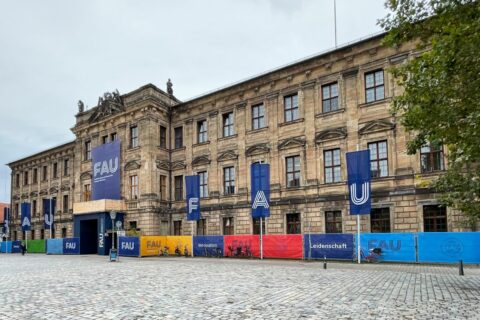Five ERC Starting Grants for FAU researchers
Young researchers receive millions of euros in EU funding
Funding from the European Research Council (ERC) is highly competitive. Receiving this funding not only provides researchers new impetus because of the high funding amounts of up to 1.5 million euros over a period of five years, but also recognizes the recipients as top-level researchers in their fields. Five FAU researchers have now been awarded an ERC Starting Grant: Silvia Budday, Alessandro Del Vecchio, Danijela Gregurec, Ferdinand Knieling and Anna Nelles, who also works as a researcher at DESY.
Silvia Budday: The brain engineer
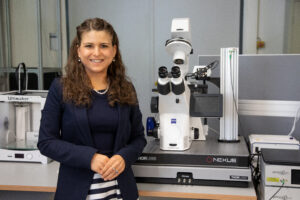
An engineer who performs research on the brain? What may initially sound a little far fetched becomes clear once you take a closer look. Prof. Dr. Silvia Budday researches the behavior of extremely soft materials under mechanical influences. These materials include hydrogels, but also human brain tissue. This is because mechanics influence the way cells function and thus also affect our health.
The aim of the MAGERY project funded by the ERC Starting Grant is to prevent damage to brain cells caused by mechanical stresses, for example during brain surgery.
By using a novel experimental setup, a combination of mechanical measurements, multiphoton microscopy and mathematical modeling and simulation, Budday and her team investigate which mechanical load levels our brain cells can withstand before they become damaged or die.
The integration of these findings into virtual or augmented reality solutions for neurosurgery could enable stresses and potential damage that occur during surgery to be reliably predicted and immediately displayed so that surgeons can react accordingly and prevent tissue and cell damage.
Prof. Dr. Silvia Budday is Chair of Continuum Mechanics and Biomechanics (LKM) at FAU; her professorship is funded by the High-Tech Agenda Bavaria. She studied mechanical engineering at the Karlsruhe Institute of Technology (KIT) where she graduated with a Bachelor’s degree in the top four of her class in 2011 and came top of her class in 2013 for her Master’s degree.
During her Master’s degree, she spent a year abroad at Purdue University in Indiana, USA. She completed her doctoral degree on the topic of “The Role of Mechanics during Brain Development” at FAU in 2017 with the grade “summa cum laude”.
From 2019, Budday led a research group on the Emmy Noether Program of the German Research Foundation (DFG) about brain mechanics across scales (BRAINIACS) before being appointed Chair at FAU. She was awarded the Heinz Maier-Leibnitz Prize of the DFG and the Federal Ministry of Education and Research (BMBF) in 2021.
Alessandro Del Vecchio: From thoughts to movements
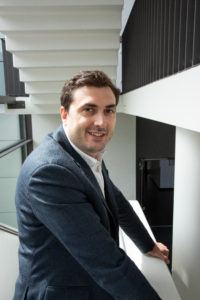
A large number of people suffer from partial or complete muscular paralysis for which there is no cure. Although neural interfaces have the potential to restore motor function with the use of assistance systems, even the most up-to-date invasive neural implants only allow patients very limited control of the movement of their paralyzed limbs because the transfer of information from the brain to the assistance systems is too imprecise.
With the ERC Starting Grant, Alessandro Del Vecchio, Professor of Neuromuscular Physiology and Neural Interfacing at FAU, hopes to develop interfaces that are better at transferring the desired movement to the prosthetic limb.
His approach starts with spinal motor neurons, which are the last cells of the nervous system that convert motor commands into movement.
In the case of most nerve injuries such as spinal cord injuries and strokes, some functioning active spinal motor neurons remain that can be accessed using minimally-invasive methods.
Del Vecchio and his team hope to develop something known as bi-directional interfaces that detect and transmit the activity of spinal motor neurons in real time. To do so, the researchers are using new deep learning methods and hundreds of sensors that measure the electrical activity of the muscles in order to record, activate and expand the action potentials of individual motor units for the muscles that control the hands, thus improving the function of assistance systems.
Prof. Dr. Alessandro Del Vecchio was appointed Professor of Neuromuscular Physiology and Neural Interfacing at FAU in 2020. He completed his Bachelor’s degree and his Master’s degree in biomechanics in 2011 and 2014 respectively and completed another Master’s degree in applied physiology at the University of Loughborough, UK, in 2015.
He subsequently completed a doctoral degree in movement neuroscience at the University of Rome Foro Italico. From 2015 to 2016 he worked as a research associate at the Department of Neurorehabilitation Engineering at the University of Göttingen, before moving to the Department of Bioengineering at Imperial College London in 2017.
Danijela Gregurec: Bimodal neuromodulation enables reading and writing in the brain
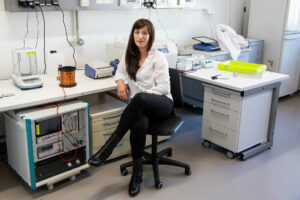
Neurodegenerative diseases and neurological dysfunction such as depression, Parkinson’s disease or dementia are affecting ever-growing sections of our society. Innovative approaches in neuroscience are required to treat these conditions effectively. Up to now, neuromodulation has usually been based on permanently implanted macroscopic hardware, which raises many safety concerns, is often not sufficiently precise and does not allow access to deeper regions of the brain.
This is where the ERC Starting Grant project called BRAINMASTER led by Prof. Dr. Danijela Gregurec comes in: Her goal is to develop an innovative bimodal, wireless and minimally-invasive system for neuromodulation that will facilitate precisely positioned and timed treatment of neurological diseases.
Functional magnetic nanoparticles form the basis of the project. These particles can be accurately positioned and activated in the brain using focused ultrasound and external magnetic fields. Magnetic resonance imaging is used to analyze the neural reaction in real time. The bimodal function enables cell-specific stimulation and simultaneous analysis of neural activity.
BRAINMASTER will thus facilitate neuromodulation without implants that can detect neuron inactivity on the cellular level and trigger the required therapeutic stimulation of affected areas of the brain within a matter of milliseconds. This means that Grecurec and her team are developing the first intuitive interface between the deep brain and a technical system in order to simplify potential cognitive training and therapies for developmental, neurodegenerative and mental conditions.
Danijela Gregurec was appointed Professor of Sensory Sciences at the Department of Chemistry and Pharmacy at FAU at the end of 2020. She is one of the pioneers in the field of magnetic wireless neuromodulation.
Prof. Dr. Danijela Gregurec studied applied chemistry at the University of Zagreb, Croatia. She carried out research in the fields of molecular biology and biomedicine at the Centro de Investigación Cooperativa en Biomateriales (CIC biomaGUNE) in San Sebastian, Spain, where she completed her doctoral degree in 2016.
She subsequently moved to the Massachusetts Institute of Technology (MIT, Cambridge, USA), where she worked in the electronics research lab and at the McGovern Institute for Brain Research.
Ferdinand Knieling: The best perspective
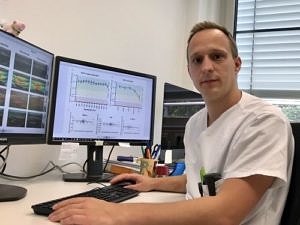
Diarrhea, stomach pains, a high temperature: Inflammatory processes in the gastrointestinal tract are often hidden behind diffuse symptoms, making early diagnosis difficult and, in the worst cases, can lead to inflammation of the peritoneum, abscesses or intestinal perforation. These processes can often only be detected with certainty and precisely located in the body using a gastroscopy or colonoscopy – an uncomfortable, invasive method with limitations.
Due to the unpleasant but necessary preparation for patients, this method is of limited use for early detection, as well as for repeated or high-risk applications, such as in children.
A non-invasive alternative is multi-spectral optoacoustic tomography (MSOT), a molecularly-sensitive ultrasound. This optical imaging method uses laser light to generate vibrations in the body that are detected using highly-sensitive detectors and are then put together to generate an image.
In his ERC-funded project, PD Dr. Dr. Ferdinand Knieling researches how MSOT can be further developed and used for the early localization of inflammatory processes in the intestines. In conjunction with his team, he discovered that dyes given orally to patients enable dynamic visualization of the entire gastric tract. The advantage of this molecular sensitive approach is that these types of contrast agents are not absorbed by the body and are passed largely unchanged by the body.
The aim of the project is to enable researchers to develop new contrast agents in order to mark inflamed areas of the intestine and to detect them via ultrasound.
Ferdinand Knieling studied medicine at the University of Göttingen and at FAU. During his degree, he completed the Molecular Imaging Program at Stanford University, USA and subsequently completed his doctoral degree at FAU.
Since then, he has had a scientific and clinical role at the Department of Pediatrics and Adolescent Medicine at Universitätsklinikum Erlangen and has completed a co-operative degree program as a clinician scientist via the Interdisciplinary Center for Clinical Research in Erlangen.
He has been head of his own research group since 2018. He completed his habilitation in 2021, and in 2023, he completed a doctoral degree in optoacoustic imaging methods.
Anna Nelles: Searching for cosmic neutrinos
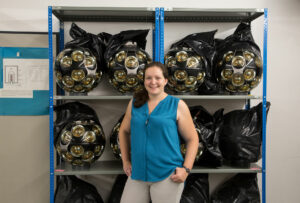
Prof. Dr. Anna Nelles, who conducts research at FAU in her role as professor of experimental astroparticle physics and also works as a researcher at the Deutsches Elektronen-Synchrotron DESY in Zeuthen (host institution for the ERC grant), is setting up a network of radio antennas in Greenland in order to detect extremely energetic neutrinos from space.
Neutrinos are volatile elementary particles that can be stopped by almost nothing. They can pass unhindered through walls, planets and entire galaxies and thus reach us from the farthest corners of the cosmos and from the center of extreme processes such as supernova explosions of stars or from the dust disks around black holes.
Some of these particles have the same amount of energy as a table tennis ball that has been hit with high force. Tests have shown that the high-speed neutrinos leave radio waves behind on their path through the atmosphere and the ice sheets in Greenland that can be detected with special antennas.
“The discovery of neutrinos with extreme amounts of energy promises to yield new findings both in astrophysics and particle physics with energy levels far beyond those achieved with particle accelerators on Earth,” explains Nelles. “We hope to discover new sources of extremely energetic cosmic rays with these observations and gain a better understanding of how these particles are distributed in space.”
The Radio Neutrino Observatory – Greenland (RNO-G) will be the first large observatory of its kind and will be set up on 35 stations by 2026. Nelles and her colleagues from the USA and Belgium are responsible for setting up and operating the observatory.
In 2019 Dr. Anna Nelles was appointed Professor of Experimental Astroparticle Physics, specializing in radio detection of neutrinos at FAU. She also works as a researcher at DESY in Zeuthen.
Nelles studied physics and business studies (MBA) at RWTH Aachen before completing her doctoral degree in physics at Nimwegen University in the Netherlands. This was followed in 2015 by a period as a postdoctoral researcher at the University of California.
Before coming to FAU, she worked as the head of an Emmy Noether research group at Humboldt Universität zu Berlin.
Further information
Communications and Press
Phone: +49 9131 85 70229
presse@fau.de
